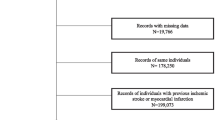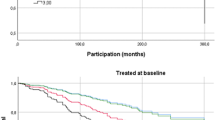Abstract
Purpose: To examine the prognosis of treated, hypertensive individuals in the Reykjavik Study
Methods: A population-based longitudinal study of 9328 men and 10 062 women. Subjects were included in the study during the period 1967-1996. Two groups of treated, hypertensive subjects were defined at baseline: with controlled blood pressure and with uncontrolled blood pressure. Main outcome measures were cardiovascular disease (CVD) mortality and all-cause mortality.
Results: Of the hypertensive men 24.8% were treated, and of those 38.3% were controlled, and of the hypertensive women 45.3% were treated, and of those 52.7% were controlled. Comparing treated and uncontrolled (systolic blood pressure (SBP) ≥160 mmHg and/or diastolic blood pressure (DBP) ≥95 mmHg) versus treated and controlled hypertensive subjects, followed for up to 30 years, the uncontrolled men and women were at significantly higher risk of CVD mortality, hazard ratio (HR) = 1.47 (95% confidence interval (CI): 1.06-2.02) and HR 1.70 (CI: 1.23–2.36), respectively, showing the benefit of hypertension control. The risk of all-cause mortality was increased for treated, uncontrolled men and women, compared with those who were treated and controlled, but did not reach significance. When analyzing blood pressure as a continuous variable among treated, hypertensive subjects, SBP was a better predictor than DBP of CVD mortality and all-cause mortality in women. This was not the case in men.
Conclusions: Control of blood pressure among hypertensive-treated subjects at baseline was associated with a lower risk of CVD mortality during follow-up. SBP was the single best predictor of CVD mortality and all-cause mortality in treated women. The uncontrolled women were at a higher risk than the uncontrolled men.
Similar content being viewed by others
References
Stamler J, Stamler R, Neaton JD. Blood pressure, systolic and diastolic, and cardiovascular risks. US population data. Arch Intern Med 1993;153:598–615.
Burt VL, Whelton P, Roccella EJ, et al. Prevalence of hypertension in the US adult population. Results from the Third National Health and Nutrition Examination Survey, 1988–1991. Hypertension 1995;25:305–313.
Hansson L, Lloyd A, Anderson P, Kopp Z. Excess morbidity and cost of failure to achieve targets for blood pressure control in Europe. Blood Press 2002;11:35–45.
Kearney PM, Whelton M, Reynolds K, Whelton PK, He J. Worldwide prevalence of hypertension: A systematic review. J Hypertens 2004;22:11–19.
Collins R, Peto R, MacMahon S, et al. Blood pressure, stroke, and coronary heart disease. Part 2, short-term reductions in blood pressure: Overview of randomised drug trials in their epidemiological context. Lancet 1990;335:827–838.
MacMahon S, Peto R, Cutler J, et al. Blood pressure, stroke, and coronary heart disease. Part 1, prolonged differences in blood pressure: Prospective observational studies corrected for the regression dilution bias. Lancet 1990;335:765–774.
Kannel WB, Sorlie P, McNamara PM. Prognosis after initial myocardial infarction: The Framingham study. Am J Cardiol 1979;44:53–59.
Sigurdsson E, Sigfusson N, Agnarsson U, Sigvaldason H, Thorgeirsson G. Long-term prognosis of different forms of coronary heart disease: The Reykjavik Study. Int J Epidemiol 1995;24:58–68.
Thurmer HL, Lund-Larsen PG, Tverdal A. Is blood pressure treatment as effective in a population setting as in controlled trials? Results from a prospective study. J Hypertens 1994;12:481–490.
Gudmundsson LS, Johannsson M, Thorgeirsson G, Sigfusson N, Sigvaldason H, Witteman JC. Risk profiles and prognosis of treated and untreated hypertensive men and women in a population-based longitudinal study. The Reykjavik Study. J Hum Hypertens 2004.
Psaty BM, Koepsell TD, Lin D, et al. Assessment and control for confounding by indication in observational studies. J Am Geriatr Soc 1999;47:749–754.
Anderson TW. Re-examination of some of the Framingham blood-pressure data. Lancet 1978;2:1139–1141.
Bulpitt CJ, Palmer AJ, Fletcher AE, et al. Optimal blood pressure control in treated hypertensive patients. Report from the Department of Health Hypertension Care Computing Project (DHCCP). Circulation 1994;90:225–233.
Alderman MH, Cohen H, Madhavan S. Distribution and determinants of cardiovascular events during 20 years of successful antihypertensive treatment. J Hypertens 1998;16:761–769.
Benetos A, Thomas F, Bean K, Gautier S, Smulyan H, Guize L. Prognostic value of systolic and diastolic blood pressure in treated hypertensive men. Arch Intern Med 2002;162:577–581.
Tuomilehto J, Ryynanen OP, Koistinen A, Rastenyte D, Nissinen A, Puska P. Low diastolic blood pressure and mortality in a population-based cohort of 16913 hypertensive patients in North Karelia, Finland. J Hypertens 1998;16:1235–1242.
Glynn RJ, Chae CU, Guralnik JM, Taylor JO, Hennekens CH. Pulse pressure and mortality in older people. Arch Intern Med 2000;160:2765–2772.
Greenberg JA. Removing confounders from the relationship between mortality risk and systolic blood pressure at low and moderately increased systolic blood pressure. J Hypertens 2003;21:49–56.
Sigurdsson E, Thorgeirsson G, Sigvaldason H, Sigfusson N. Prevalence of coronary heart disease in Icelandic men 1968-1986. The Reykjavik Study. Eur Heart J 1993;14:584–591.
Jonsdottir LS, Sigfusson N, Sigvaldason H, Thorgeirsson G. Incidence and prevalence of recognised and unrecognised myocardial infarction in women. The Reykjavik Study. Eur Heart J 1998;19:1011–1018.
Rose G, McCartney P, Reid DD. Self-administration of a questionnaire on chest pain and intermittent claudication. Br J Prev Soc Med 1977;31:42–48.
Rose GA, Blackburn H. Cardiovascular population studies: Methods. Geneva: World Health Organization 1966.
Rose GA, Blackburn H. Cardiovascular Survey Methods. WHO Monogr Ser. Vol. 56. Geneva: WHO, 1968.
The World Health Organization MONICA Project (monitoring trends and determinants in cardiovascular disease): A major international collaboration. WHO MONICA Project Principal Investigators. J Clin Epidemiol 1988;41:105–114.
Sigfusson N, Sigvaldason H, Steingrimsdottir L, et al. Decline in ischaemic heart disease in Iceland and change in risk factor levels. BMJ 1991;302:1371–1375.
Bjornsson OJ, Davidsson D, Olafsson O. Survey of Serum Lipid Levels in Icelandic Men Aged 34–61 Years. An epidemiological and statistical evaluation. Acta Med Scand 1977;Suppl:616.
Sigurdsson E, Sigfusson N, Sigvaldason H, Thorgeirsson G. Silent ST-T changes in an epidemiologic cohort study–a marker of hypertension or coronary heart disease, or both: The Reykjavik study. J Am Coll Cardiol 1996;27:1140–1147.
Cox DR. Regression models and lifetables. Journal of the Royal Statistical Society 1972;34:187–220.
2003 European Society of Hypertension-European Society of Cardiology guidelines for the management of arterial hypertension. J Hypertens 2003;21:1011–1053.
Gebsky V, Leung O, McNeil D, Lunn D. Statistical package for interacrive data analysis (SPIDA): Statistical computing lab, 1992.
Trafford JA, Horn CR, O’Neal H, McGonigle R, Halford-Maw L, Evans R. Five year follow-up of effects of treatment of mild and moderate hypertension. Br Med J (Clin Res Ed) 1981;282:1111–1113.
Antikainen RL, Jousilahti P, Vanhanen H, Tuomilehto J. Excess mortality associated with increased pulse pressure among middle-aged men and women is explained by high systolic blood pressure. J Hypertens 2000;18:417–423.
Bertakis KD, Azari R, Helms LJ, Callahan EJ, Robbins JA. Gender differences in the utilization of health care services. J Fam Pract 2000;49:147–152.
Wolf HK, Tuomilehto J, Kuulasmaa K, et al. Blood pressure levels in the 41 populations of the WHO MONICA Project. J Hum Hypertens 1997;11:733–742.
Sesso HD, Stampfer MJ, Rosner B, et al. Systolic and diastolic blood pressure, pulse pressure, and mean arterial pressure as predictors of cardiovascular disease risk in men. Hypertension 2000;36:801–807.
Caro JJ, Salas M, Speckman JL, Raggio G, Jackson JD. Persistence with treatment for hypertension in actual practice [see comments]. Cmaj 1999;160:31–37.
Majernick TG, Zacker C, Madden NA, Belletti DA, Arcona S. Correlates of hypertension control in a primary care setting. Am J Hypertens 2004;17:915–920.
Bulpitt CJ, Beevers DG, Butler A, et al. Treated blood pressure, rather than pretreatment, predicts survival in hypertensive patients. A report from the DHSS Hypertension Care Computing Project (DHCCP). J Hypertens 1988;6:627–632.
Perry HM, Jr., Miller JP, Baty JD, Carmody SE, Sambhi MP. Pretreatment blood pressure as a predictor of 21-year mortality. Am J Hypertens 2000;13:724–733.
Author information
Authors and Affiliations
Corresponding author
Rights and permissions
About this article
Cite this article
Gudmundsson, L.S., Johannsson, M., Thorgeirsson, G. et al. Hypertension Control as Predictor of Mortality in Treated Men and Women, Followed for up to 30 Years. Cardiovasc Drugs Ther 19, 227–235 (2005). https://doi.org/10.1007/s10557-005-1643-0
Issue Date:
DOI: https://doi.org/10.1007/s10557-005-1643-0




